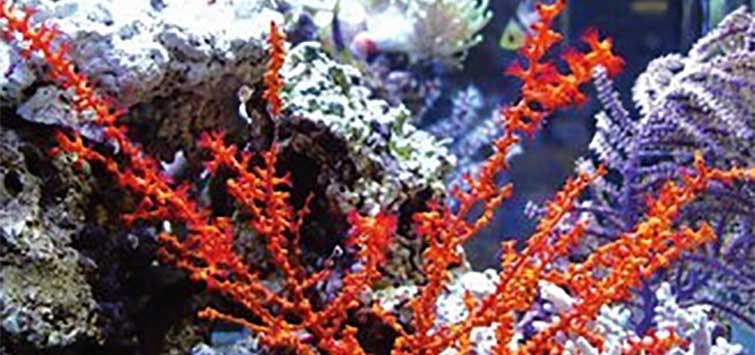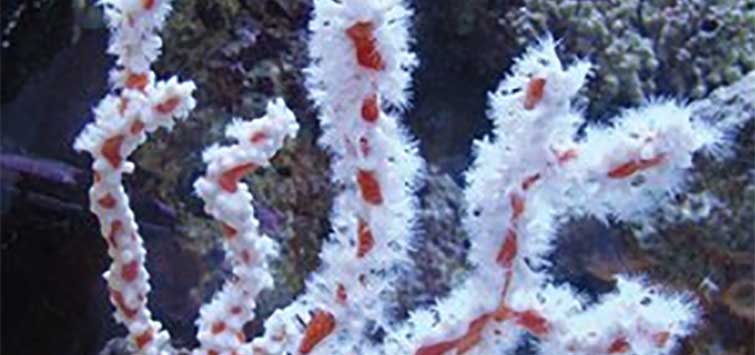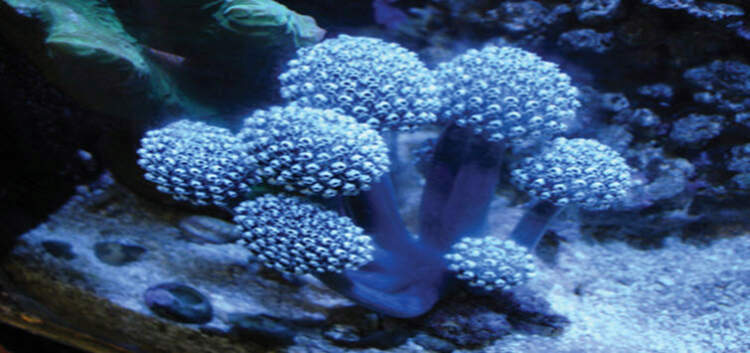Swiftia exserta
Common Names: Red gorgonian, red-polyped gorgonian, orange sea fan, orange tree gorgonian
Phylum: Cnidaria
Class: Anthozoa
Order: Gorgonacea
Family: Paramuriceidae
Range: Tropical Western Atlantic Ocean (Florida and the Bahamas)
Natural Environment: This non-photosynthetic species is found in fairly deep (e.g., 50 to 100 feet) and nutrient-rich waters experiencing moderate currents along coastal areas. They usually inhabit surfaces under overhangs or the interior walls of caves.
Water Requirements: Calcium 380 to 430 ppm, alkalinity 2.5 meq/l, pH 8.1 to 8.2, specific gravity 1.025, nitrate >25 ppm, phosphate <0.015 ppm, and a temperature range of 68° to 76°F (20° to 24°C). Concerning iodine additives, use and monitor as their manufacturers recommend.
Captive Care
Placement in the aquarium and its feeding is extremely important if there is to be any level of success with this species. It should be placed in a shady area, preferably a cave-like area, receiving a gentle to moderate water current passing through it—i.e., from its opening to its opposite opening, and where it’s easy to direct a gentle flow, possibly from a turkey baster, of phytoplankton and zooplankton products upon its polyps at least twice a day. Consider two feedings per day a very real minimum, as three or four feedings per day are better, yet may still not be adequate for long-term health. This species also seems to fare better in somewhat nutrient-rich surroundings, and where iodine additives are constantly used and monitored.
Keep in mind that direct hand-feeding of this species is absolutely necessary, and it might be better if this species was maintained in a refugium-like environment dedicated to sponges and other non-photosynthetic species, and/or where system filtration can adequately handle the extra feeding attention this species requires.
Also consider enriching its foodstuffs with commercial supplements having highly unsaturated fatty acids (HUFAs) containing omega-3 fatty oils, such as eicosapentaenoic acid (EPA), docosahexaenoic acid (DHA), and alpha-linolenic acid (ALA), as this seemed to have a positive effect on the specimen I maintained in a separate 20-gallon tank with two power filters and a white moonlight. Nevertheless, even with much dedicated care, I did not have long-term (over one year) success with this species.
This very pretty cnidarian with orange branches and red polyps shows up in the trade quite frequently, though it’s not a common species in the wild. That’s because it’s a highly colorful and showy animal, and collectors know there is a market for such attractive species/specimens. Nevertheless, unless it can be provided its needed environmental and nutritional needs, including a somewhat cooler water temperature as noted below, this is a species that is better left in the wild. The species is certainly tempting, but it is difficult to maintain for any length of time.

.png?h=595&iar=0&w=2781&hash=5FD5E69473BCC22199FBFA2FB71B6033)



